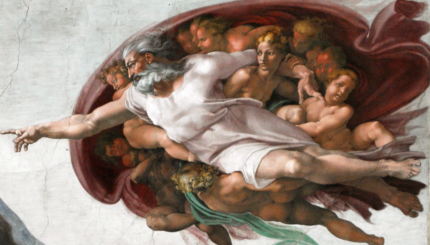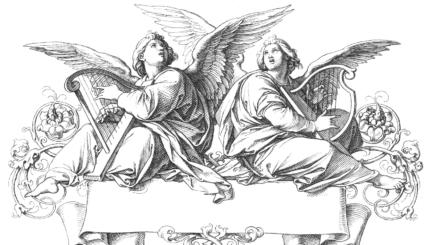Modern man is still affected by the belief that given names are vessels for the soul and that character can be manipulated through the use of names. For Jews themost important names in any period were and still are the names of God, whichwere associated with the forces of good. It is for this reason that the main thrust of amuletic development was through incantations and formulae based on permutations of the names of God and the angels.
The invocation of names for assistance became prominent in post-talmudic times. Although many angels were called upon to intercede for man, the names of God were of primary importance and power.
The most awesome and well-known name was the Tetragrammaton, the four Hebrew letters forming the ineffable name. All other names were intended to act as substitutesfor the most powerful name, which should not be used lightly. The Bible tells us how even the High Priest prepared and cleansed himself before uttering the awesome name, and he did so only on the Day of Atonement.
Numerical Equivalents
In order to increase the mysterious effect of amulets and charms, a number of methods were used in the computation and derivation of the names. Every letter of the 22-letter Hebrew alphabet has a numerical equivalent. Through the method of gematria,every letter of a word can be reduced to its numerical value and explained by another word of the same value, but with no other obvious relationship.
The reduction can be simply aleph=one, bet=two,and so on. The process can also be more elaborate and confusing through the use of mispar katan–small numbers, i.e., reducing every number to its simplest unit. Through this methodthe letter yod, ordinarily ten, would equal one (1+0), kuf, ordinarily 100, would equal one (1+0+0), lamed, ordinarily 30, would equal three (3+0), shin, ordinarily 300, would also equal three (3+0+0), and so on.
Abbreviation Methods
Themethods of serugin and notarikon are methods of abbreviation. Throughthe use of either initial or final letters of one or several words, new wordsare formed.
Forexample, you may find the words emet and shema on an amulet;literally they mean “truth” and “hear.” However, emet is equal to the final letters of Genesis 2:3 (bara elohim la’asot), and shema is derived from the initial letters of Isaiah 40:20 (seumaromainehem), meaning “raise your eyes on high.”
Letter Substitution
Temurah is a method of substituting or transposing letters in order to replace the original word with an artificial equivalent. The temurah method has a number of subcategories.
The atbashmethod is derived by folding the alphabet in half so that the first lettercan be substituted for the last letter or the last for the first. The letters betor shin may be similarly substituted, as may any of the other pairs. The name MZPZ–the inversion of YHVH–is derived through this method.
Avgadis the substitution or replacement of a letter by its preceding letter–bet by alef, dalet by gimmel, andso on. The name KOZU is derived through this method.
Albam is the division of the alphabet into two sections of 11 letters, permitting the substitution of alef for lamed, bet for mem, and so on.
Names for God
Thefamiliar opening phrase from the shema prayer becomes, through thetemurah method atbash, the 14-letter name KOZU B’MOCSAZ KOZU, nowfrequently found on the lower back of the mezuzah parchment.
The 22-lettername ANKATAM PASTAM PASPASIM DYONSIM was first mentioned in Sefer Raziel. The number of its letters and words corresponds to Numbers 6:24-25 ,now familiar as part of the priestly benediction, “May the Lord bless you and keep you, may the Lord shine …” The name was frequently used incharms and invocations and became important to the magician.
Thename of 42 letters consists of seven groups, each containing six letters. It isderived from the first 42 letters of Genesis (1:1). The name, already known tothe scholar Hai Gaon in the year 1000, may be utilized in its entirety or inany of its seven parts. The second part, K’RA SATAN (literally”rend Satan”), is used to help one who has gone mad or who has beenattacked by evil spirits.
Thename is written on an amulet and hung around the neck of the victim. The fifth termis equal numerically through the gematria method to the angel Gzrel, and both terms equal 241. By calling the name, the angel is invoked to countermandan evil decree issued in heaven. The name is followed by the term beshikhmelu, an abbreviated form of “Blessed is His glorious name forever and ever.”
Themost complicated and therefore most powerful name is of 72 letters. It iscomposed of triads of syllables based on three verses in Exodus 14:19-21, eachverse containing 72 letters. The triads were formed by taking a letter fromeach verse in the following manner:
Firsttriad: first letter of verse 19; last letter of verse 20; first letter of verse 21.
Second triad: second letter of verse 19; next to last letter of verse 20; second letter of verse 21.
Andso on until all 72 letters were used. Any combination of triads could be used as a name. The name was often used to quench fire and as a weapon against uncleanthoughts.
Reprinted with permission from Magic & Superstition in the Jewish Tradition (Spertus Institute of Judaic Studies).

Help us keep Jewish knowledge accessible to millions of people around the world.
Your donation to My Jewish Learning fuels endless journeys of Jewish discovery. With your help, My Jewish Learning can continue to provide nonstop opportunities for learning, connection and growth.
gematria
Pronounced: guh-MAH-tree-yuh, Origin: Greek, a numerological system by which Hebrew letters correspond to numbers, used in Jewish mysticism as a way of interpreting Jewish texts.

Help us keep Jewish knowledge accessible to millions of people around the world.
Your donation to My Jewish Learning fuels endless journeys of Jewish discovery. With your help, My Jewish Learning can continue to provide nonstop opportunities for learning, connection and growth.


